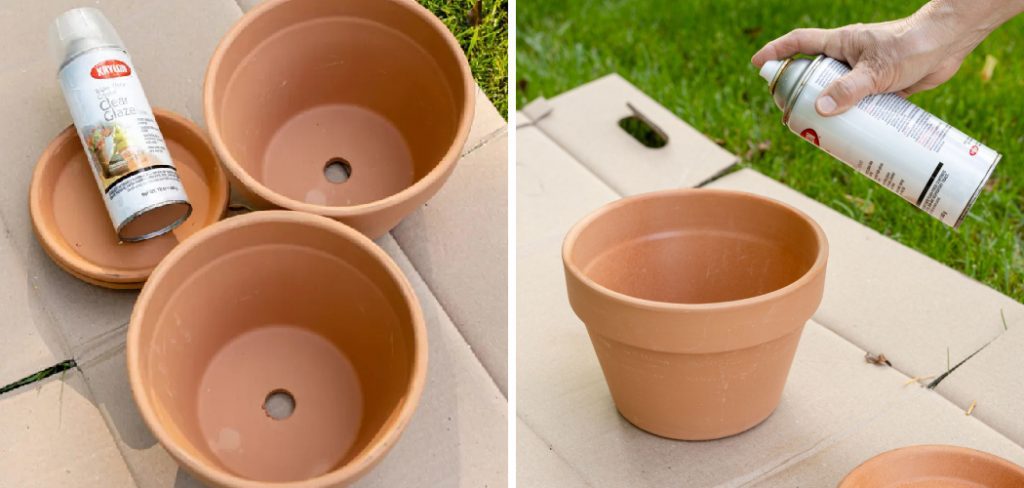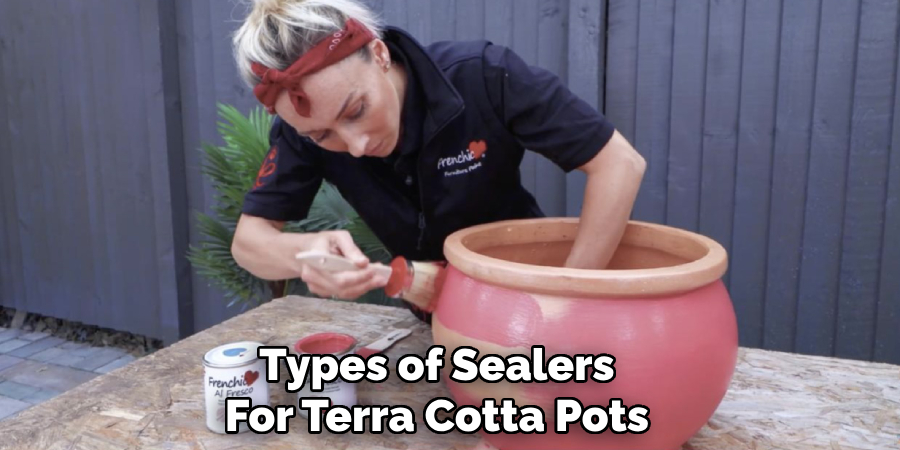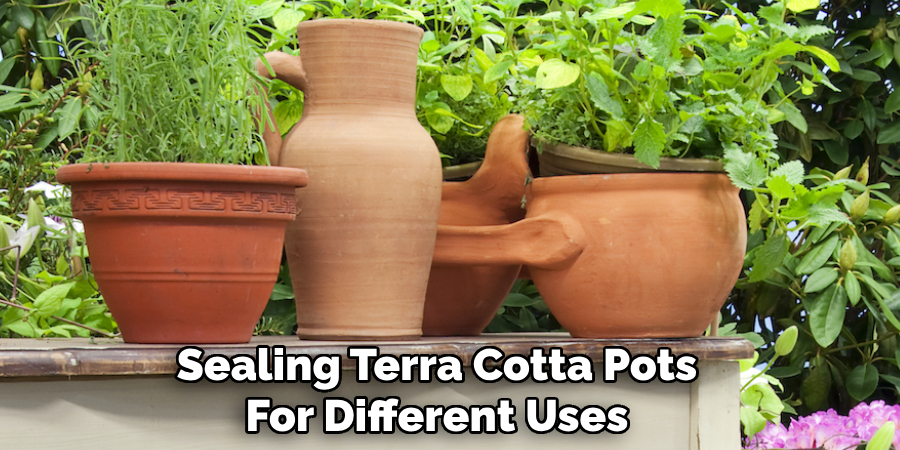Terra cotta pots have long been a favorite among gardening enthusiasts and home décor lovers alike. Their natural, earthy charm seamlessly blends with a variety of plants and interior styles, making them both functional and aesthetically pleasing.

However, these porous clay pots are prone to absorbing moisture, which can lead to cracking, weakening, or discoloration over time. This is where sealing becomes essential. Sealing terra cotta pots not only offers protection from water damage but also prolongs their lifespan and enhances their overall appearance.
The purpose of this article is to provide a comprehensive step-by-step guide on how to seal terra cotta pots effectively, ensuring they remain durable and beautiful for both indoor and outdoor use. By following the proper sealing techniques, you can enjoy the many benefits these pots offer while keeping them in pristine condition for years to come.
Why Seal Terra Cotta Pots?
Porous Nature of Terra Cotta
Terra cotta is inherently a porous material, meaning it readily absorbs water due to its composition of baked clay. While this property aids in allowing plant roots to breathe by facilitating air and moisture exchange, it can also lead to issues over time.
Prolonged water absorption weakens the pot’s structure, making it susceptible to cracks and fractures, particularly in outdoor settings where the elements play a significant role in its degradation.
Benefits of Sealing
Sealing terra cotta pots offers several notable advantages. By creating a protective barrier, sealing prevents water absorption, reducing the risk of cracks caused by freeze-thaw cycles in colder climates.
This is especially important for outdoor pots exposed to fluctuating temperatures. Additionally, sealing helps to minimize staining and prevents unsightly mineral buildup from hard water. Beyond protection, sealing also preserves the pot’s original color and enhances its finish, ensuring a clean and polished appearance that complements any plant design.
When Sealing is Most Important
Sealing is crucial for outdoor pots, particularly in regions with harsher winters where freezing and thawing can rapidly compromise the pot’s integrity. For indoor pots, sealing may be less critical, but it still provides the benefit of reducing staining and preserving aesthetics, especially when used for decorative purposes.
Types of Sealers for Terra Cotta Pots
Penetrating Sealers
Penetrating sealers, such as silicone or water-based options, soak into the terra cotta to provide protection while maintaining a natural look.
These types of sealers are breathable, allowing moisture to escape, which helps to prevent cracking or damage over time. However, because they penetrate the surface rather than forming a protective layer, they may need reapplication more frequently, especially for pots exposed to the elements.

Surface Sealers
Surface sealers, like acrylic or polyurethane sealers, create a protective layer on the exterior of the pot. These sealers often produce a shiny or glossy finish, which can enhance the visual appeal of the pot. However, they are less breathable than penetrating sealers, which may lead to issues like trapping moisture inside the pot. This type of sealer is ideal for indoor pots or when you want a polished, decorative finish.
Natural Alternatives
For those seeking a more eco-friendly option, natural alternatives like wax or linseed oil can also be used to seal terra cotta pots. These options provide a protective barrier while keeping the natural appearance of the pot intact. They are a sustainable choice but may not offer the same durability or level of protection as commercial sealers.
Choosing the Right Sealer
When selecting a sealer for your terra cotta pots, consider factors such as where the pot will be used (indoor or outdoor), the desired finish (natural or glossy), the size of the pot, and your budget. These elements will help you determine the best type of sealer to meet both functional and aesthetic needs.
Preparing Terra Cotta Pots for Sealing
Before sealing your terra cotta pots, it is crucial to prepare them properly to ensure the sealer adheres well and provides maximum protection. Here are the key steps to follow:
Cleaning the Pot
Start by removing any dirt, mineral deposits, or old sealers that may be present on the pot. Using a soft brush or sponge, clean the surface with a solution of vinegar and water or mild detergent mixed with water. Be thorough, especially in any crevices or textured areas, to ensure a clean surface. Rinse the pot well with water after cleaning and allow it to sit for a while to ensure no cleaning solution residue remains.

Drying the Pot Thoroughly
A completely dry surface is essential before applying the sealer, as moisture trapped under the sealant can lead to peeling or ineffective application. Allow the pot to air dry in a warm, dry area. If needed, you can use a clean, dry cloth to pat it down, but make sure there is no residual moisture left in the porous material.
Repairing Cracks or Chips
Inspect your pot for any cracks or chips, as these imperfections can compromise the durability of the seal. Use a terra cotta filler or an epoxy suitable for ceramic materials to repair damage. Follow the manufacturer’s instructions for application, and ensure that the filler is fully cured before moving to the next step.
Sanding the Surface (If Needed)
If the pot has rough areas or uneven surfaces, use sandpaper to smooth them out. This ensures an even sealer application and enhances the final appearance. Gently sand the areas, and wipe away any dust created in the process before sealing.
By preparing the pot correctly, you create the ideal foundation for the sealing process, helping to extend the life and beauty of your terra cotta pots.
How to Seal Terra Cotta Pots: Step-by-Step Sealing Process
Applying the Sealer
To apply the sealer, choose the method that works best for your specific product—whether it’s a brush, spray, or cloth. If using a brush, apply it in smooth, even strokes to avoid streaks. For spray sealers, ensure an even distribution by holding the can at least 6-8 inches from the surface and moving in a steady, overlapping motion.
When using a cloth, work in small sections, rubbing the sealer into the surface with consistent pressure. Pay close attention to corners and edges, as these areas are prone to be missed, and avoid allowing drips or pooling for a smooth finish.
Number of Coats Required
For optimal protection, it’s recommended to apply 2-3 thin coats of sealer. More coats provide greater durability, especially for pots that will be used outdoors or exposed to fluctuating weather conditions. Be sure not to apply overly thick layers, as this can result in uneven surfaces or prolong the drying process.

Drying Time Between Coats
Allow sufficient drying time between each coat, as specified on the sealer’s instructions—typically 24 hours. Proper drying ensures a durable finish and prevents issues like bubbling or peeling after the sealant cures. Avoid rushing this step to achieve the best results.
Final Inspection and Touch-Ups
Once the final coat is fully dried, inspect the pot closely for any missed spots or irregularities. If necessary, apply touch-ups to ensure complete coverage. A thorough inspection ensures a professional finish and enhances the pot’s ability to withstand the test of time. With the sealer applied properly, your terra cotta pot is now ready for planting or decorative display.
Sealing Terra Cotta Pots for Different Uses
Indoor Use
When sealing terra cotta pots for indoor use, the primary focus is on aesthetics and providing light moisture protection. Use a clear, matte or gloss sealer depending on your desired finish to enhance the natural beauty of the pot while preventing water marks from indoor plants.
Since indoor conditions typically do not expose pots to extreme elements, less heavy-duty sealants are sufficient. Ensure the sealer is non-toxic if the pots will house edible plants or sensitive species.
Outdoor Use
For outdoor pots, the emphasis shifts to weatherproofing and protection against freeze-thaw cycles. Outdoor conditions can cause unsealed terra cotta pots to crack or degrade over time. Use a durable, waterproof sealant to guard against moisture absorption and temperature fluctuations.

Applying multiple coats of a high-quality exterior-grade sealant ensures the pot remains intact and prevents damage from prolonged exposure to sunlight, rain, or snow.
Using Sealed Pots for Plants That Need Good Drainage
For plants that require excellent drainage, it’s essential to preserve the functionality of drainage holes even after sealing. Avoid blocking these holes entirely during the sealing process. Instead, carefully apply sealant around the edges of the drainage holes to ensure the pot remains waterproof elsewhere while allowing water to escape efficiently. This method enables healthy plant growth with protected and functional terra cotta pots.
Maintaining Sealed Terra Cotta Pots
Proper maintenance of sealed terra cotta pots ensures their longevity and effectiveness. Here are some tips to care for your pots:
Cleaning Tips
When cleaning sealed terra cotta pots, always use gentle methods to avoid damaging the protective sealer. A soft brush or cloth with mild soap and water is ideal for removing dirt and debris. Avoid using abrasive tools or harsh chemicals, as they can compromise the sealant.
Re-Sealing Frequency
The frequency of re-sealing depends on factors like exposure to weather elements and the pot’s overall use. For outdoor pots, reapplying the sealant every 1-2 years is recommended. Indoor pots may require re-sealing less often, typically every 2-3 years.
Signs That Re-Sealing is Needed
Look for key indicators that your pot needs re-sealing, such as increased water absorption, discoloration of the surface, or visible wear and cracks in the sealant. Timely re-sealing will protect your pots from damage and preserve their functionality.

Common Mistakes to Avoid
When sealing pots, there are common mistakes that can impact the effectiveness and longevity of the seal.
Sealing a Wet or Dirty Pot
Applying sealant to a pot that is wet or dirty can significantly affect adhesion and the finish quality. Moisture or contaminants on the surface prevent the sealant from bonding properly, leading to uneven coverage or peeling. Ensure the pot is clean and thoroughly dry before beginning the sealing process.
Using the Wrong Type of Sealer
Choosing an inappropriate sealer can cause breathability issues, which affect the health of plants, or result in an undesirable appearance. Always select a sealer specifically designed for the material of your pot, such as terracotta or ceramic, to achieve the best results.
Applying Too Many or Too Few Coats
Using too many coats of sealant may result in peeling or cracking over time, while too few coats fail to provide sufficient protection. Follow the manufacturer’s instructions carefully to apply the ideal number of coats for durability and performance.
Neglecting Drainage Holes
Overlooking the drainage holes can lead to waterlogging and root rot, which negatively affect plant health. Apply sealant carefully around the drainage holes, ensuring they remain functional and unblocked. Proper preparation in this area is crucial for maintaining healthy plants and effective pot performance.
Conclusion
Sealing terra cotta pots is an essential step to ensure their longevity, functionality, and aesthetic appeal. Properly following the recommended steps on how to seal terra cotta pots can help protect them from water damage, prevent cracking, and maintain plant health by managing moisture levels effectively.
Choosing the right sealer and applying it carefully, especially around areas like drainage holes, is key to success. Regular maintenance will extend the life of your pots while enhancing their beauty and strength. By sealing your terra cotta pots, you can enjoy a harmonious blend of durability and timeless charm in your garden or home.
Specialization:
- Master of wheel-throwing, hand-building, and advanced glazing techniques
- Focus on creating both functional pottery and decorative art pieces
Recognition:
- Celebrated by collectors and art enthusiasts for creating one-of-a-kind pieces that blend artistry with functionality
- Participates in local and national exhibitions, earning accolades for his innovative designs and craftsmanship
Passion:
- Deeply committed to exploring and pushing the boundaries of ceramic artistry
- Continuously experiments with new materials, firing techniques, and artistic concepts to evolve his craft
Personal Philosophy:
- Believes in the transformative power of art, aiming to evoke emotions and connections through his ceramic creations
- Advocates for sustainability in ceramics, using eco-friendly materials and practices whenever possible


